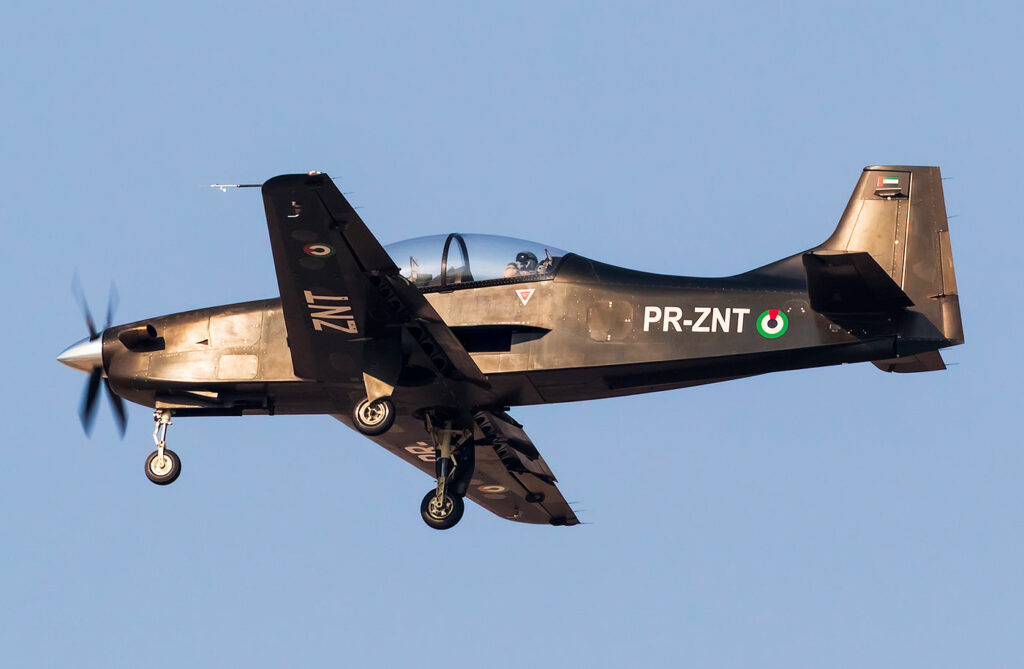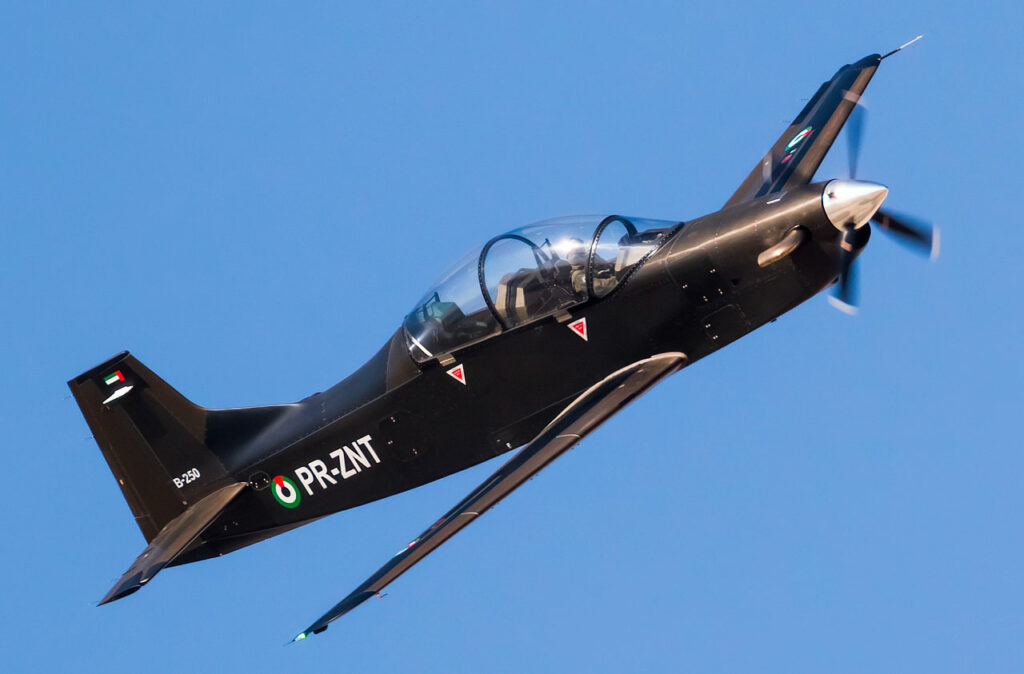The Calidus B-250 is a carbon-fiber, tandem-seat, turboprop aircraft designed for light attack, counter-insurgency, and advanced training missions.
The Calidus B-250 is a light attack and trainer aircraft featuring a carbon-fiber structure, making it lighter than its competitors. Powered by a single Pratt & Whitney Canada PT6A-68 turboprop engine producing 1,600 horsepower, it achieves a maximum speed of approximately 301 knots (556 km/h) and a service ceiling of 30,000 feet (9,144 meters). The aircraft has seven hardpoints capable of carrying up to 3,960 pounds (1,796 kg) of mixed ordnance, including precision-guided munitions. Equipped with Rockwell Collins Pro Line Fusion II avionics, it supports missions such as counter-insurgency (COIN), close air support (CAS), intelligence, surveillance, and reconnaissance (ISR), and advanced pilot training.
History of the Development of the Calidus B-250 (Bader)
In the mid-2010s, the global defense landscape saw an increased demand for versatile aircraft capable of performing both light attack and training missions. Traditional jet-powered platforms were often cost-prohibitive for many nations, leading to a resurgence in interest for turboprop aircraft that could deliver effective performance with lower operational costs.
Recognizing this need, Calidus LLC, an Emirati company, initiated the B-250 program in 2015. They partnered with Brazilian firm Novaer for design and development, leveraging Novaer’s expertise in aircraft design. The project was led by Joseph Kovács, a renowned designer known for his work on the Embraer Tucano. The collaboration aimed to produce an aircraft that was not only effective in combat roles but also suitable for pilot training, particularly for air forces with limited budgets.
The development phase was notably swift. Within 25 months, the first prototype was completed, leading to its maiden flight in July 2017. The aircraft was publicly unveiled at the Dubai Airshow in November 2017, where it garnered significant attention for its modern design and capabilities.
In 2019, the United Arab Emirates Air Force placed an order for 24 B-250 aircraft, signaling confidence in the platform’s potential. This order underscored the UAE’s commitment to bolstering its defense capabilities with domestically developed technology.
As of 2024, reports emerged of a collaboration between Calidus and Indonesia to transform the B-250 into an unmanned combat aerial vehicle (UCAV). This initiative aimed to integrate avionics, surveillance systems, and weaponry from both nations, reflecting the platform’s adaptability to evolving warfare requirements.
The B-250’s development reflects a strategic response to the need for cost-effective, versatile military aircraft in the 21st century. Its emphasis on modern materials, advanced avionics, and multi-role capability positions it as a competitive option for nations seeking to enhance their air power without incurring the high costs associated with jet-powered platforms.

Design of the Calidus B-250 (Bader)
The Calidus B-250’s design integrates modern materials and systems to achieve a balance between performance, durability, and operational flexibility.
Airframe and Materials:
The B-250 features a low-wing monoplane configuration with a retractable tricycle landing gear. Its airframe is constructed entirely from carbon fiber, a choice that reduces weight and enhances structural strength. This construction results in a lighter aircraft compared to traditional aluminum designs, contributing to improved fuel efficiency and maneuverability.
Dimensions:
- Length: Approximately 35.7 feet (10.88 meters)
- Wingspan: Approximately 39.7 feet (12.1 meters)
- Height: Approximately 12.4 feet (3.79 meters)
These dimensions provide a compact profile suitable for various operational environments.
Cockpit:
The tandem-seat cockpit is equipped with Martin-Baker ejection seats, ensuring crew safety in emergency situations. The canopy design offers excellent visibility, crucial for both training and combat scenarios. The cockpit is outfitted with the Rockwell Collins Pro Line Fusion II avionics suite, featuring large multifunction displays that provide pilots with critical flight and mission data.
Avionics and Systems:
The Pro Line Fusion II avionics suite integrates navigation, communication, and surveillance systems, enhancing situational awareness and mission effectiveness. The aircraft also supports optional equipment such as the L3 Wescam MX-15Di electro-optical/infrared (EO/IR) turret, which can be utilized for surveillance and targeting purposes.
Hardpoints and Armament:
The B-250 is equipped with seven hardpoints: six under the wings and one on the centerline. These hardpoints can carry a combined payload of up to 3,960 pounds (1,796 kg), accommodating a variety of munitions, including precision-guided bombs, rockets, and gun pods. This versatility allows the aircraft to be configured for diverse mission profiles, from light attack to close air support.
Landing Gear:
The reinforced landing gear is designed to operate from semi-prepared airstrips, increasing the aircraft’s deployment flexibility in austere environments.
Advantages and Drawbacks:
The use of carbon fiber reduces the overall weight, enhancing performance and fuel efficiency. The advanced avionics suite provides pilots with comprehensive situational awareness. However, reliance on advanced materials and systems may increase production and maintenance costs. Additionally, as a turboprop aircraft, the B-250 is less suited for operations requiring supersonic speeds or stealth capabilities, limiting its role in contested environments dominated by advanced air defenses. Despite these limitations, it excels in scenarios where cost-efficiency and versatility are prioritized.
Performance of the Calidus B-250 (Bader)
The performance characteristics of the Calidus B-250 make it a competitive option in the light attack and advanced trainer categories, balancing efficiency, speed, and payload capacity.
Engine and Power:
The B-250 is powered by a single Pratt & Whitney Canada PT6A-68 turboprop engine, delivering 1,600 shaft horsepower (1,193 kW). This engine is widely recognized for its reliability and efficiency, particularly in rugged operational environments. The six-bladed Hartzell propeller complements the engine by offering a smooth and efficient power transfer.
Speed and Altitude:
The B-250 achieves a maximum speed of 301 knots (556 km/h), making it suitable for a range of light attack and reconnaissance missions. Its cruise speed is approximately 230 knots (426 km/h), providing an optimal balance of speed and fuel efficiency. The aircraft’s service ceiling is 30,000 feet (9,144 meters), enabling it to operate above most threats during surveillance and intelligence missions.
Range and Endurance:
The B-250 boasts an impressive range of 2,400 nautical miles (4,445 km) with auxiliary fuel tanks, making it ideal for extended missions. Its endurance is rated at 12 hours, depending on mission configuration and payload, allowing for prolonged operations in ISR (intelligence, surveillance, and reconnaissance) roles.
Payload Capacity:
With a maximum payload of 3,960 pounds (1,796 kg) spread across seven hardpoints, the B-250 can carry a diverse array of armaments, including:
- Precision-guided bombs such as GBU-12 and GBU-58 Paveway II.
- Unguided rockets for close air support.
- Gun pods for strafing missions.
- ISR equipment like the EO/IR turret for surveillance missions.
Maneuverability and Efficiency:
The B-250’s lightweight carbon-fiber structure enhances its maneuverability, allowing it to perform agile movements essential for close air support and training. Additionally, its aerodynamic efficiency ensures reduced operational costs compared to heavier, metal-framed aircraft.
Comparison to Competitors:
The B-250 competes with aircraft such as the Embraer A-29 Super Tucano and the Textron AT-6 Wolverine. While it shares similar roles with these platforms, the B-250’s full carbon-fiber structure provides a weight advantage, leading to improved fuel efficiency and operational flexibility. However, the A-29’s combat record and established production line may offer an edge in terms of reliability and market trust.
Variants of the Calidus B-250 (Bader)
The B-250 program primarily revolves around its baseline model, with discussions and potential future configurations aimed at expanding its capabilities.
1. Standard B-250:
The standard configuration includes the full suite of avionics, ISR capabilities, and the ability to carry various munitions. This model is tailored for light attack, close air support, and advanced training missions.
2. ISR Variant:
An Intelligence, Surveillance, and Reconnaissance (ISR) variant has been proposed, featuring advanced EO/IR systems and data link equipment for real-time battlefield awareness. This configuration prioritizes long endurance and surveillance capabilities over offensive payloads.
3. Potential UCAV Variant:
In collaboration with Indonesia, there are discussions to develop an unmanned combat aerial vehicle (UCAV) variant of the B-250. This configuration would integrate autonomous flight systems, making it suitable for high-risk missions in contested environments.

Military Use and Combat of the Calidus B-250 (Bader)
The Calidus B-250 has been designed for roles including light attack, counter-insurgency, and advanced pilot training. Its versatility ensures applicability in diverse military operations.
Armament:
The B-250 can carry a wide range of weaponry across its seven hardpoints, including:
- Air-to-ground munitions: Precision-guided bombs such as the GBU-12 and unguided rockets for close air support.
- Air-to-air missiles: Short-range missiles like the AIM-9 Sidewinder for basic air defense capabilities.
- Gun pods: Typically carrying 12.7 mm or 20 mm guns for strafing and ground attack roles.
- Surveillance equipment: Optional EO/IR systems for ISR missions.
This loadout makes the B-250 a versatile platform for both offensive and defensive roles.
Combat Scenarios:
Although the B-250 is relatively new and has not seen extensive combat deployment, its design caters to counter-insurgency and asymmetric warfare. It excels in operations against lightly armed adversaries in environments where high-speed jets would be cost-inefficient or unsuitable.
Operations and Training:
The aircraft is particularly effective in training scenarios. Its advanced avionics suite mirrors those found in more complex platforms, providing trainee pilots with realistic operational experience. Its versatility also allows it to transition seamlessly between training and combat missions.
Market and Export:
The United Arab Emirates Air Force has been the primary operator of the B-250, ordering 24 units. Interest has also been expressed by other nations, particularly those with limited defense budgets seeking cost-effective solutions for light attack and ISR missions. If the UCAV variant is realized, the B-250 could attract further attention from countries seeking unmanned capabilities.
Competing Aircraft:
The B-250 competes with aircraft like the A-29 Super Tucano and AT-6 Wolverine in roles such as counter-insurgency and advanced training. While the B-250 offers advantages in materials and efficiency, its competitors benefit from established service records and mature production lines.
Future Prospects:
As of now, the B-250 remains in limited service. Its success depends on further export deals and adaptations to emerging warfare requirements, such as the potential UCAV variant. The aircraft’s ability to adapt to diverse mission profiles positions it as a viable option for air forces seeking cost-effective solutions.
The Calidus B-250 combines modern materials, advanced avionics, and versatile weapon systems to address the demands of light attack and advanced training roles. Its lightweight carbon-fiber structure enhances efficiency and performance, while its modular design allows for diverse mission configurations. Though it faces competition from established platforms, the B-250 offers a cost-effective and adaptable alternative for nations requiring flexibility in military operations. Its potential for future development, including unmanned capabilities, ensures continued relevance in the evolving defense landscape.
Back to the Special Aircraft section